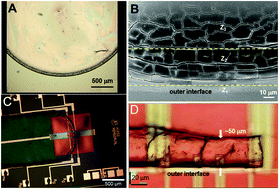Microstructural metrology of tobacco mosaic virus nanorods during radial compression and heating†
Abstract
We determined stress-induced deformations and the thermal stability of nanorod-shaped tobacco mosaic virus (TMV) capsids in coffee-ring structures by X-ray nanodiffraction. The hexagonal capsids lattice transforms under compression in the outer boundary zone of the coffee-ring into a tetragonal lattice. The helical pitch of the nanorods increases by about 2.5% across the outer boundary zone while the lateral distance between nanorods decreases continuously across the whole coffee-ring structure by about 2% due to compressive forces. The diffraction patterns show a mixture of helical scattering and Bragg peaks attributed to a lattice of nanorods interlocked by their helical grooves. Thermo-nanodiffraction reveals water loss up to about 100 °C resulting in a reduction of the helical pitch by about 6% with respect to its maximum value and a reduction of the nanorods separation by about 0.5 nm. Up to about 200 °C the pitch is increasing again by about 2%. Secondary crystallization in the bulk reaches a maximum at 150–160 °C. At higher temperatures the crystallinity is continuously decreasing up to about 220 °C. Above about 200 °C and depending on the heating history, the nanorods start disintegrating into small, randomly oriented aggregates.



 Please wait while we load your content...
Please wait while we load your content...